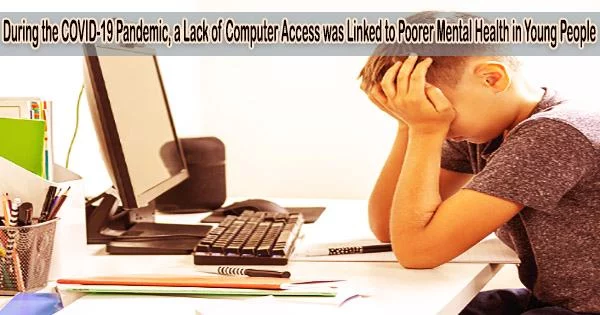Lack of access to a computer was connected to lower mental health among young people and adolescents during COVID-19 lockdowns, according to Cambridge researchers.
The team discovered that the end of 2020 was the most challenging time for young people and that the mental health of those young people who did not have access to a computer tended to decline more than that of their peers who did.
The COVID-19 pandemic had a substantial impact on the mental health of young people, with evidence of increased anxiety, depression, and psychological distress. People are more prone during adolescence to acquiring mental health illnesses, which can have long-term effects into adulthood.
In the UK, the mental health of children and adolescents was already deteriorating before the pandemic, but the proportion of people in this age group likely to be experiencing a mental health disorder increased from 11% in 2017 to 16% in July 2020.
The epidemic resulted in school closures and an increase in online education, the effects of which were not felt equally. Adolescents without computer access had the most disruption: in one study, 30% of middle-class students reported participating in live or recorded school lessons every day, while just 16% of working-class kids reported doing so.
In addition to school closures, lockdowns often meant that young people could not meet their friends in person. During these periods, online and digital forms of interaction with peers, such as through video games and social media, are likely to have helped reduce the impact of these social disruptions.
Tom Metherell, who at the time of the study was an undergraduate student at Fitzwilliam College, University of Cambridge, said: “Access to computers meant that many young people were still able to ‘attend’ school virtually, carry on with their education to an extent and keep up with friends. But anyone who didn’t have access to a computer would have been at a significant disadvantage, which would only risk increasing their sense of isolation.”
Young people’s mental health tended to suffer most during the strictest periods of lockdown, when they were less likely to be able go to school or see friends. But those without access to a computer were the worst hit their mental health suffered much more than their peers and the change was more dramatic.
Tom Metherell
To examine in detail the impact of digital exclusion on the mental health of young people, Metherell and colleagues examined data from 1,387 10-15-year-olds collected as part of Understanding Society, a large UK-wide longitudinal survey. They focused on computer access rather than smartphone access because education is mostly done on a computer and most social contacts happen in person at school at this age.
The results of their study are published in Scientific Reports.
Participants completed a questionnaire that assesses common childhood psychological difficulties, which allowed the Understanding Society team to score them on five areas: hyperactivity/inattention, prosocial behavior, emotional, conduct, and peer relationship problems. From this, they derived a ‘Total Difficulties’ score for each individual.
Over the course of the pandemic, the researchers noted small changes in overall mental health of the group, with average Total Difficulties scores increasing form pre-pandemic levels of 10.7 (out of a maximum 40), peaking at 11.4 at the end of 2020 before declining to 11.1 by March 2021.
Those young people who did not have access to a computer experienced the greatest increase in Total Difficulties scores. While both groups of young people had identical scores at the outset of the epidemic, when adjusted for sociodemographic characteristics, those without computer access had their average scores rise to 17.8, compared to 11.2 for their counterparts.
Almost one in four (24%) young people in the group without computer access had Total Difficulties scores classed as ‘high’ or ‘very high’ compared to one in seven (14%) in the group with computer access.
Metherell, now a PhD student at UCL, added: “Young people’s mental health tended to suffer most during the strictest periods of lockdown, when they were less likely to be able go to school or see friends. But those without access to a computer were the worst hit their mental health suffered much more than their peers and the change was more dramatic.”
Dr. Amy Orben from the Medical Research Council (MRC) Cognition and Brain Sciences at the University of Cambridge, the study’s senior author, added: “Rather than always focusing on the downsides of digital technology on young people’s mental health, we need to recognize that it can have important benefits and may act as a buffer for their mental health during times of acute social isolation, such as the lockdown.”
“We don’t know if and when a future lockdown will occur, but our research shows that we need to start thinking urgently how we can tackle digital inequalities and help protect the mental health of our young people in times when their regular in-person social networks are disrupted.”
According to the study, governments and public health professionals must recognize the hazards of ‘digital exclusion’ to young people’s mental health and prioritize ensuring equal digital access.
Tom Metherell was supported by the British Psychological Society Undergraduate Research Assistantship Scheme. The research was largely funded by the Medical Research Council.





